Tibetan Elephant Taming Picture Series (original) (raw)
ZEN IRODALOM ZEN LITERATURE ****« Zen index** « Home
Meditation Instruction:
Calm Abiding Represented as a Painting Meditation
Deepening Calm-Abiding - The Nine Stages of Abiding
Tibetan Taming the Elephant and 普明 Puming's Ten Oxherding Pictures Compared
Le dressage de l'éléphant dans le bouddhisme tibétain par Catherine Despeux (PDF)
Meditation Instructions for Calm Abiding (Shamatha) in the form of a painting with accompanying instructions. The idea of relating the mind to an unruly elephant along with the monkey and other elements in the visual example of Calm Abiding meditation originates in the writings of Asanga and then later in the meditation commentaries of Je Tsongkapa. It is thought that the artistic depiction of the practice is relatively late and possibly first arose in the 19th century as a wall mural. The image above is of a poster published in India in the early 1970s. (See a black and white line drawing of the same image).
Key Elements:
- The monk holding an elephant goad and a lasso is the individual.
- The flame represents effort.
- The elephant represents the mind.
- Black elephant colour - the mental factor of sinking - lethargy.
- The monkey is distraction.
- Black monkey colour - the mental factor of scattering.
- The Five Objects of Sensory Pleasure are the object of distraction.
- The rabbit represents subtle sinking - lethargy.
(Jeff Watt)
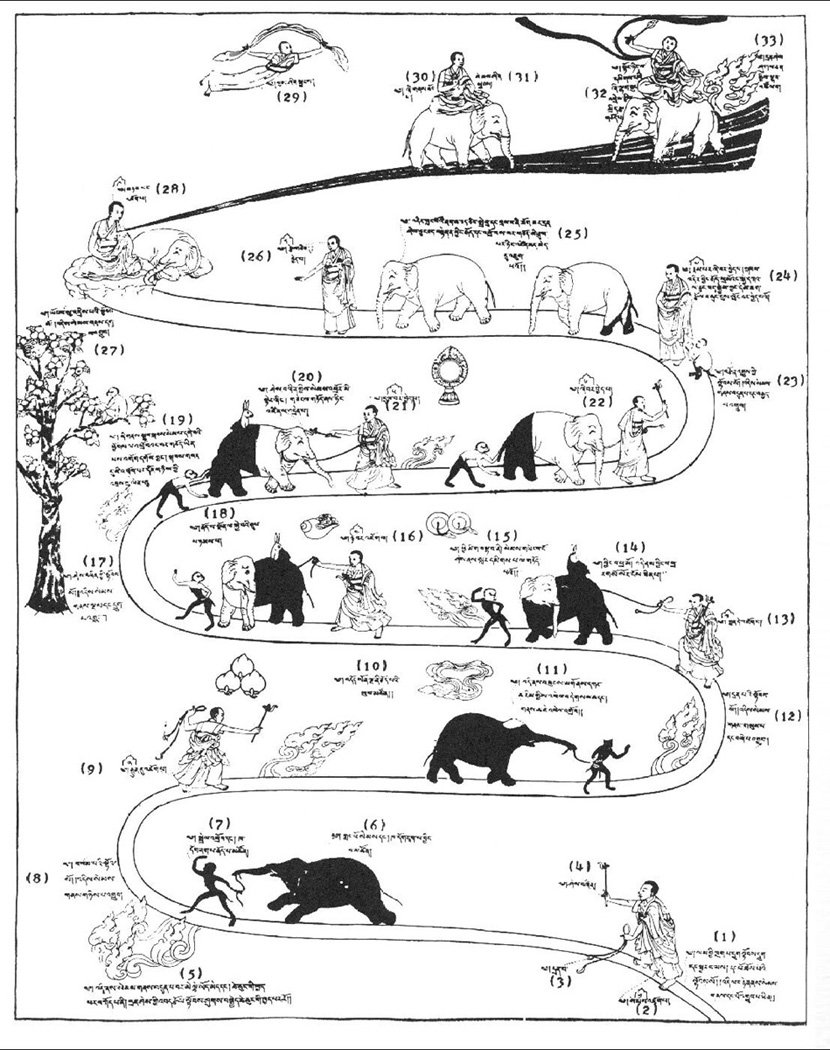
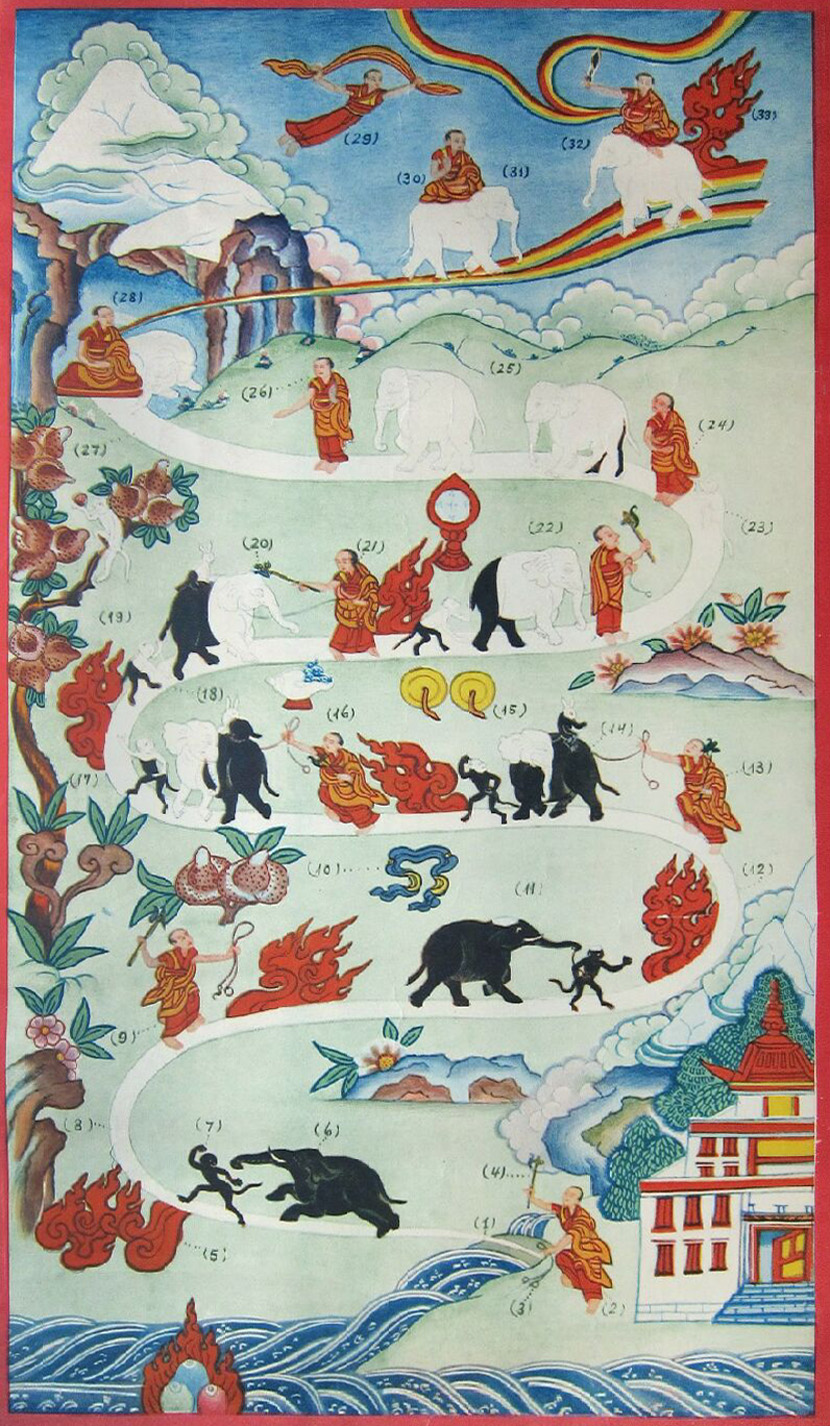
http://www.himalayanart.org/image.cfm/59661.html
Tibetan Commentary:
(1)
The first is the force of Hearing. the First Stage of Meditation is attained through the Force of Hearing.
(2)
Fixing the Mind on the object of concentration.
(3)
The force of recollection (Mindfulness).
(4)
The Froce of Consciousness (Clear Comprehension).
(5)
From here until the Seventh Stage of Mental Absorption will be found a flame decreasing in sizes at each progressive stage until it becomes conspicuously absent. This difference in sizes, absence and presence of the flame denotes the mesure of efforts and strenght required of Recollection and consciousness.
(6)
The elephant represents mind, and its black colour, the mental factor of Sinking.
(7)
The monkey represents interruption (distraction) and its black colour, the mental factor of Scattering.
(8)
The Force of Reflection. This achieves the Second Stage of Mental Absorption.
(9)
Uninterrupted and continuous absorption on the object of concentration (lenghtening of the period of concentration).
(10)
The Five Sensual Desires are the object of the mental factor of Scattering.
(11)
From here, the black colour, beginning form the head changes into white. It denotes the progress in the clear grasp of the object of meditation, and prolonged fixing of the mind on the object of meditation.
(12)
The Force of Recollection. The attainment of the Third and Fourth Stages of Mental Absorption is acheived through the Force of Recollection.
(13)
To return and fix the strayed mind on the object of concentration.
(14)
The hare represents the subtle aspects of the mental factor of Sinking. At this stage, one recognizes the distinct nature of the subtle and gross aspects of the mental factor of Sinking.
(15)
Looking back means that having perceived the diversion of the mind, it is again brought back to the object of concentration.
(16)
Maintaining a clear conception of even the minutest detail of the object of concentration.
(17)
The Force of Consciousness (Clear Comprehension). Through this is attained the Fifth and Sixth Stages of Mental Absorption.
(18.
The arising of the mental factor of Scattering preceding the actual State of absorption is greatly reduced.
(19)
At the time of Samatha Meditation even though thouths of virtue arises, these had to be eliminated and the mind teneciously projected on the object of concentration. The reason is that such thought, in spite of its virtuousness will act as interruption. Such elimination is not necessary when one is not doing Samatha Meditation.
(20)
The Force of Consiousness (Clear Comrehension) arrests the mind from drifting astray, and because of its sheer loftiness, the mind is drawn towards absorption.
(21)
The mind is controlled.
(22)
The mind is pacified.
(23)
The force of Mental Energy. The Seventh and Eight Stages of Mental Absorption are accoplished through the Force of mental Energy.
(24)
The mind becomes perfectly pacified. At this stage the arising of the subtlest Sinking and Scattering will be not possible. Even if there occurs some, it will be immediately removed with the slightest effort.
(25)
Here the black colour of the elephant has completely faded out, and the monkey has also been left out. The meaning represented is: bereft of the interrupting factors of Scattering and Sinking the mind can be settled continously in absorption (on the object of concentration) with perfect ease and steadfastness, beginning with the application of a slight amount of the Forces of Minfulness and Clear Comprehention.
(26)
One-pointedness of mind.
(27)
The Force of Perfection. The Ninth Stage of Mental Absorption is attained through the Force of Perfection.
(28)
Perfect equanimity.
(29)
Ecstasy of body.
(30)
Attainment of mental quiescense or Samantha.
(31)
Mental ecstasy.
(32)
The roots of Samsara or Becoming is destroyed with the joint power of Samatha and the Direct Insight (Vipassana) with Sunyata (Void) as the object of concentration.
(33)
The flame represents the dynamic forces of Recollection (Mindfulness) and Consciousness (Clear Comprehension). Equipped with this power, one examines the nature and the sublime meaning of Sunyata (Void), the Knowledge of the ultimate reality of all objects, material and phenomenal.
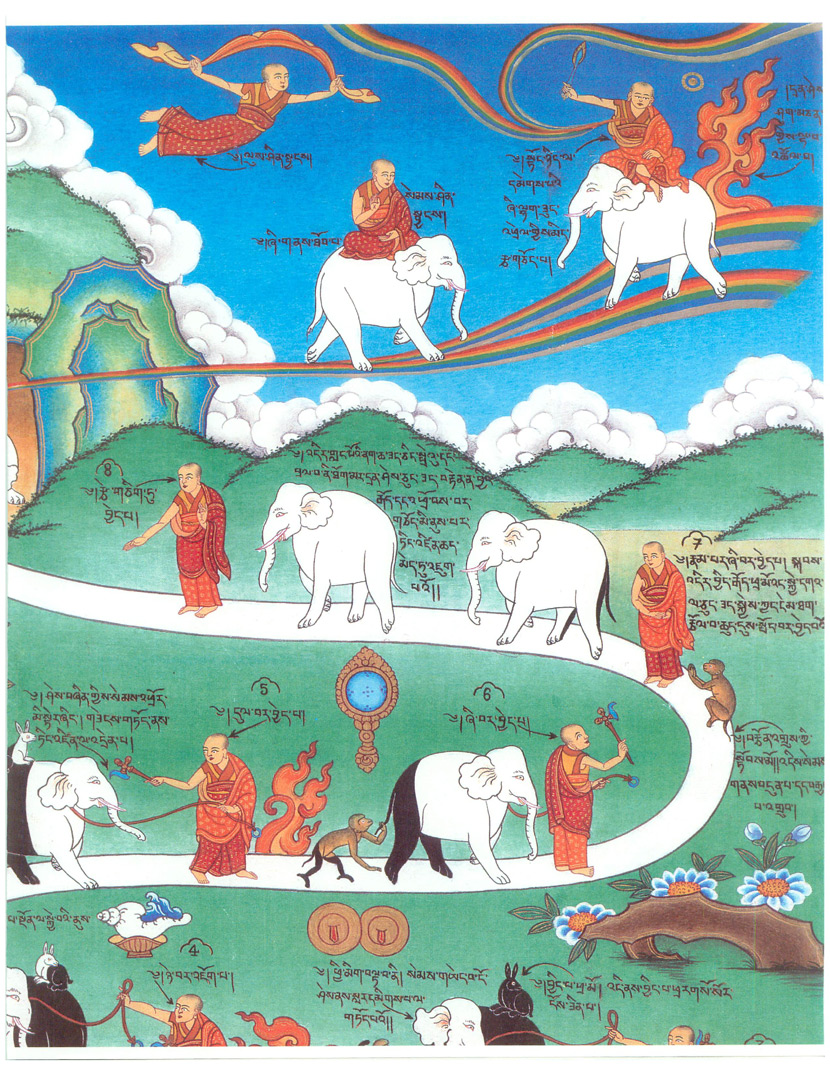
http://glimpseoftibet.com/thankas.html
The Path of Calm A man, an elephant, and a monkey are repeatedly depicted on an ascending road with sharp curves. The man represents the meditator, the elephant symbolizes the mind, and the monkey stands for the mind's agitation. At the outset, the monkey leads the elephant, and the man pursues them from a distance. Eventually, the man gains control over the elephant, and the monkey disappears. The ever-increasing stillness of mind (samatha) is also expressed through the use of black and white: the elephant and the monkey start out completely black, but their blackness recedes in each successive scene until both animals are completely white. The Path of Calm and the Oxherding Pictures probably have historical links. In terms of basic structure, the maps discussed above employ distinctly different patterns: a circle with multiple sectors, a flat line with directional movement, and an ascending line that zigzags.
Training the elephant-like mind
Tibetan Taming the Elephant and 普明 Puming's Ten Oxherding Pictures Compared
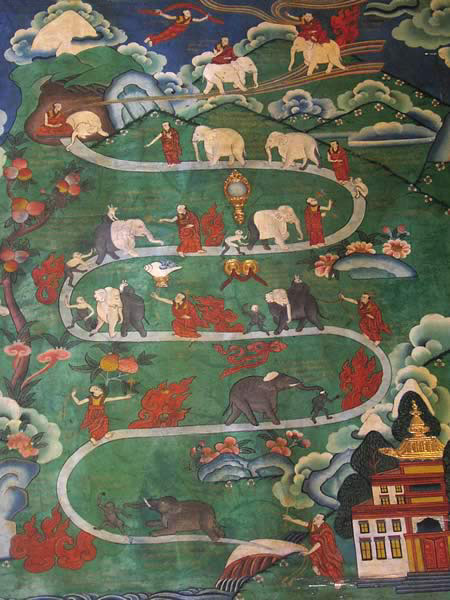
This painting from a Tibetan Buddhist monastery is like a cartoon strip showing stages of a monk calming his mind through meditation training.
- At the bottom you see a new monk whose mind wanders so much in its own directions that it resembles a muddy elephant led by a naughty monkey. The monk is running after it.
- Half-way up, his mind, the elephant, has been partly cleaned up and it is the monk who is now leading it – though the monkey is still interfering by pulling the elephant’s tail from behind.
- Further up, the elephant is now clean and the monk alone is in charge – he is saying goodbye to the monkey.
- Next the monk can get the elephant to lie down and finally he can ride it.
- At the top the monk is fully in charge of the elephant, his mind, and is now riding down to put its powers to good use.
The Perfection of Concentration
by Geshe Rabten Rinpoche
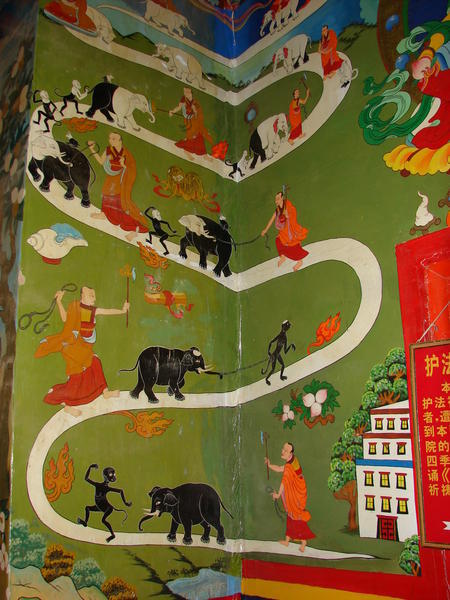
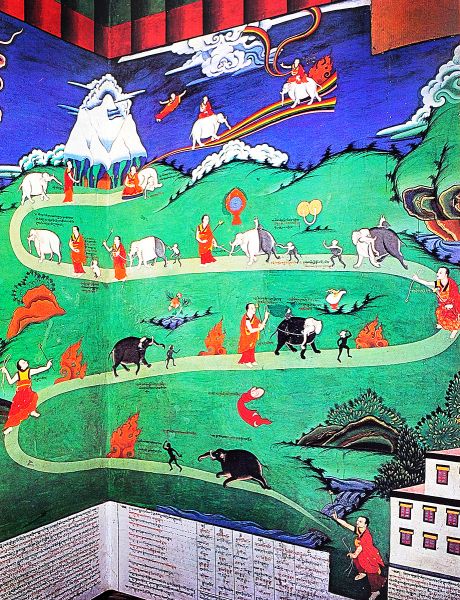
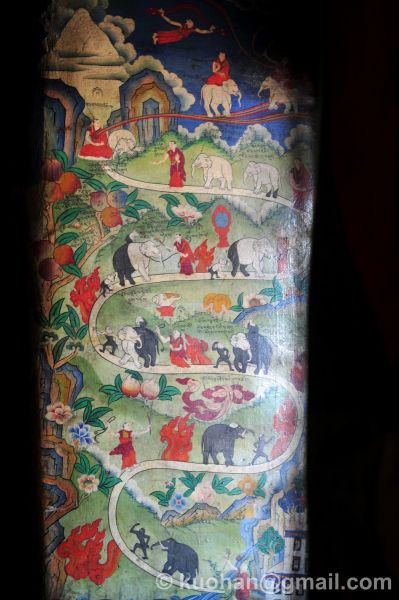
Tibetan wall murals
Although merely sitting in the vajra posture produces a good frame of mind, this is not enough. The main work, that done by the mind, has not yet even begun. The way to remove a thief who has entered a room is to go inside the house and throw him out, not to sit outside and shout at him. If we sit on top of a mountain and our mind constantly wanders down to the village below, little is achieved.
Concentration has two enemies, mental agitation, or busyness, and mental torpor, or numbness.
Generally, agitation arises from desire. An attractive object appears in the mind and the mind leaves the object of meditation to follow it.
Torpor arises from subtle apathy developing within the mind.
In order to have firm concentration these two obstacles must be eliminated. A man needs a candle in order to see a painting which is on the wall of a dark room. If there is a draught of wind the candle will flicker too much for the man to be able to see properly and if the candle is too small its name will be too weak. When the flame of the mind is not obstructed by the wind of mental agitation and not weakened by the smallness of torpor it can concentrate properly upon the picture of the meditation object.
In the early stages of the practice of concentration mental agitation is more of a hindrance than torpor. The mind is continually flying away from the object of concentration. This can be seen by trying to keep the mind fixed on the memory of a face. The image of the face is soon replaced by something else.
Halting this process is difficult, for we have built the habit of succumbing to it over a long period of time and are not accustomed to concentration. To take up the new and leave behind the old is always hard. Yet, because concentration is fundamental to all forms of higher meditation and to all higher mental activity, one should make the effort.
Mental agitation is overcome principally by the force of mindfulness and torpor by attentive application. In the diagram representing the development of _zhi-nay_there is an elephant. The elephant symbolizes the meditator's mind. Once an elephant is tamed, he never refuses to obey his master and he becomes capable of many kinds of work. The same applies to the mind. Furthermore, a wild and untamed elephant is dangerous, often causing terrible destruction. Just so, the untamed mind can cause any of the sufferings of the six realms.
At the bottom of the diagram depicting the development of concentration the elephant is totally black. This is because at the primary stage of the development of _zhi-nay_mental torpor pervades the mind.
In front of the elephant is a monkey representing mental agitation. A monkey cannot keep still for a moment but is always chattering and fiddling with something, being attracted to everything.
The monkey is leading the elephant. At this stage of practice mental agitation leads the mind everywhere.
Behind the elephant trails the meditator, who is trying to gain control of the mind. In one hand he holds a rope, symbolic of mindfulness, and in the other he holds a hook, symbolic of alertness.
At this level the meditator has no control whatsoever over his mind. The elephant follows the monkey without paying the slightest attention to the meditator. In the second stage the meditator has almost caught up with the elephant.
In the third stage the meditator throws the rope over the elephant's neck. The elephant looks back, symbolizing that here the mind can be somewhat restrained by the power of mindfulness. At this stage a rabbit appears on the elephant's back. This is the rabbit of subtle mental torpor, which previously was too fine to be recognized but which now is obvious to the meditator.
In these early stages we have to apply the force of mindfulness more than the force of mental attentive application for agitation must be eliminated before torpor can be dealt with.
In the fourth stage the elephant is far more obedient. Only rarely does he have to be given the rope of mindfulness.
In the fifth stage the monkey follows behind the elephant, who submissively follows the rope and hook of the meditator. Mental agitation no longer heavily disturbs the mind.
In the sixth stage the elephant and monkey both follow meekly behind the meditator. The meditator no longer needs even to look back at them. He no longer has to focus his attention in order to control the mind. The rabbit has now disappeared.
In the seventh stage the elephant is left to follow of its own accord. The meditator does not have to give it either the rope of mindfulness or the hook of attentive application. The monkey of agitation has completely left the scene. Agitation and torpor never again occur in gross forms and even subtly only occasionally.
In the eighth stage the elephant has turned completely white. He follows behind the man for the mind is now fully obedient. Nonetheless, some energy is still required in order to sustain concentration.
In the ninth stage the meditator sits in meditation and the elephant sleeps at his feet. The mind can now indulge in effortless concentration for long periods of time, even days, weeks or months.
These are the nine stages of the development of zhi-nay. The tenth stage is the attainment of real zhi-nay represented by the meditator calmly riding on the elephant's back.
Beyond this is an eleventh stage, in which the meditator is depicted as riding on the elephant, who is now walking in a different direction. The meditator holds a flaming sword. He has now entered into a new kind of meditation called vipasyana, or higher insight: (Tibetan: Lhag-mthong). This meditation is symbolized by his flaming sword, the sharp and penetrative implement that cuts through to realization of Voidness.
At various points in the diagram there is a fire. This fire represents the effort necessary to the practice of zhi-nay. Each time the fire appears it is smaller than the previous time. Eventually it disappears. At each successive stage of development less energy is needed to sustain concentration and eventually no effort is required. The fire reappears at the eleventh stage, where the meditator has taken up meditation on voidness.
Also on the diagram are the images of food, cloth, musical instruments, perfume and a mirror. They symbolize the five sources of mental agitation, i.e. the five sensual objects: those of taste, touch, sound, smell and sight, respectively.
(Translated by Gonsar Rinpoche. Prepared by Glenn Mullin and Michael Lewis. Printed in From Tushita, edited and published by Michael Hellbach, Tushita Editions, 1977.)
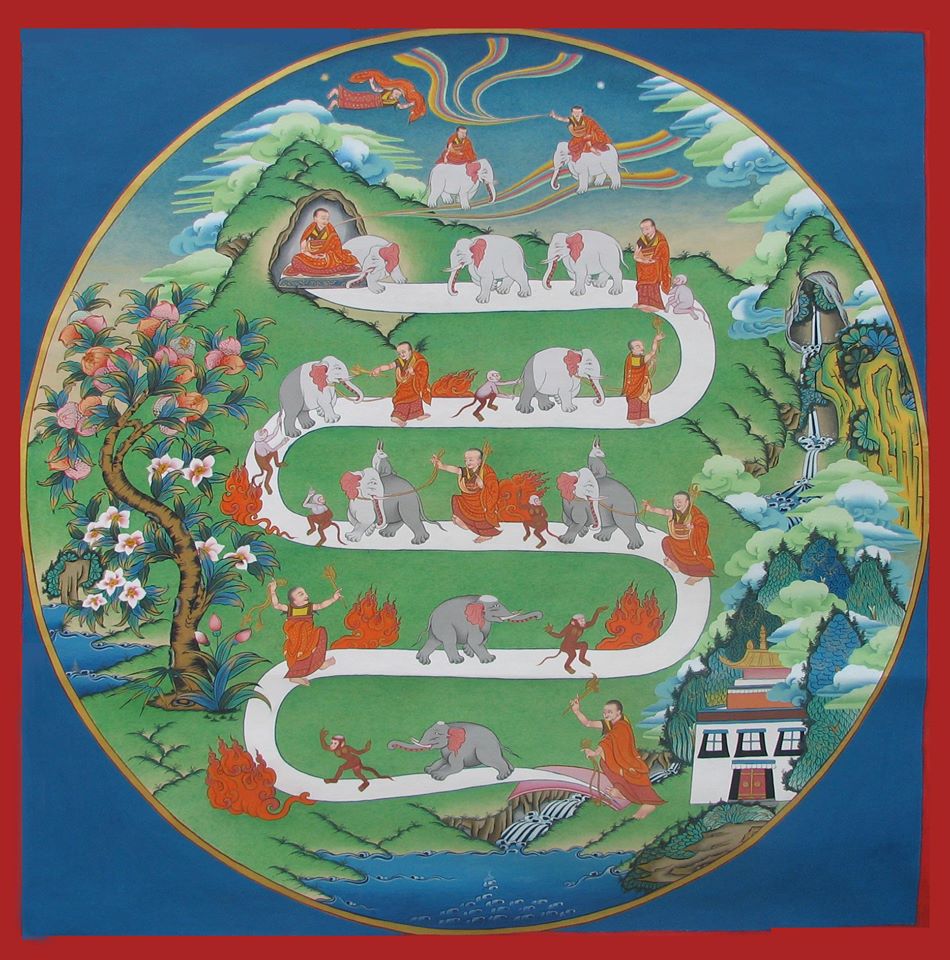
Piya Tan
The pilgrim’s progress
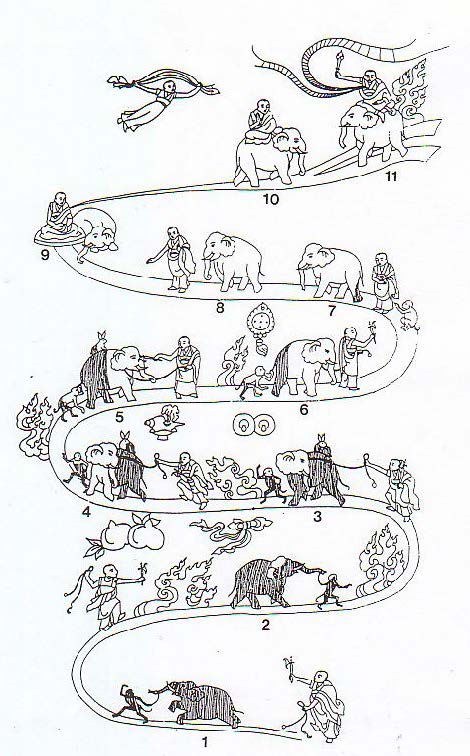
http://dharmafarer.org/wordpress/wp-content/uploads/2009/12/8.2-Taming-of-the-Bull-piya.pdf
A teaching similar to the simile of the Mahā Gopālaka Sutta (M 33) is found in the Vajrayāna depiction of the practitioner’s progress on the spiritual path. The Vajrayvna model however is a diachronic one, that is, it depicts progressive stages of development. It is depicted as a pathway traversed by a monk (the meditator), a black elephant and a black monkey in eleven stages. The elephant represents the mind and its blackness is the “sinking of the mind” or torpor (Tib jingwa, Skt nirmagnata, Pali middha). A wild elephant is dangerous; so is an untrained mind. The elephant’s footprint, which is very large, here represents mental defilements. The black monkey (“scattering of the mind” or restlessness: Tib gopa, Skt auddhatya, Pali uddhacca) leads the elephant: restlessness results when our mind runs after worldly things.
The explanation of the Tibetan meditation picture simile is as follows:
(1)
A monk (the meditator), holding a rope (mindfulness) (Tib denpa; Skt smrti, Pali sati) in his lefthand and a goad (full awareness) in his right, runs after an elephant led by a monkey. Here the meditator has no control over his mind.
(2)
He almost catches up with the elephant.
(3)
The monk throws a noose around the elephant’s neck and it looks back; the mind is beginning to be restrained by mindfulness. The rabbit on the elephant’s back represents torpor which has by then become subtle.
(4)
As the elephant (the mind) becomes more obedient, the rope (mindfulness) needs less pulling.
(5)
The elephant is being led by the rope and the hook, and the monkey follows behind. There is less restlessness now; mainly full awareness is used.
(6)
Both the animals follow behind and the monk does not have to look back (he focusses his attention continuously on his mind); the rabbit (subtle restlessness) has disappeared.
(7)
The elephant is left on its own doing without the need of rope or hook; the monkey takes leave. Torpor and restlessness—both mild—ocur only occasionally here.
(8)
The elephant, now completely white, follows behind the man; the mind is obedient and there is no torpor or restlessness but some energy is still needed to concentrate.
(9)
The monk sits in meditation while the elephant sleeps at his feet; the mind is able to concentrate without effort for long periods of time and there is great joy and peace. The flying monk represents zest and lightness of the body.
(10)
The monk sits on the elephant; he now finds true calm (Tib zhine, Skt samatha, Pali samatha) and needs less energy to concentrate.
(11)
In the last stage, the monk on the elephant’s back holds a sword (the realization of emptiness, sunyatā) and cuts off the two black lines representing the obstacle to full knowledge (jñey’āvarana) and the defiling obstacle (kles’āvarana). The term āvarana is a synonym for nívarana (mental hindrance) (D 1:246,Sn 66 1005, Nc 379, Divy 378). The monk is here cultivating insight (Tib lhagthong, Skt vipasyanā, Pali vipassanā) and on his way to the perfection of wisdom.
Fire appears at different stages of the path. This represents the energy necessary for meditation. It gradually diminishes at the calm stages as less energy is needed to concentrate. It flares up again at the last stage when the monk is practising insight.
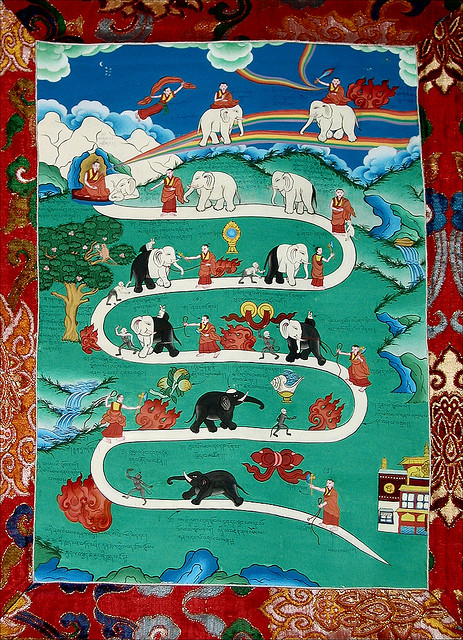
http://sunyatanamaskara.blogspot.com/2011/02/path-of-samatha-meditation.html
PATH OF SAMATHA MEDITATION by Andy Weber
(Tibetan: Chi.nae) The painting here represents an aspiring meditator, who is following the path consisting of the stages of meditation that ends in the accomplishment of a calmly abiding mind and the beginning of the practice of insight meditation. At the bottom we see the practitioner, who holds a rope in one hand and a hook in the other, chasing after an elephant led by a monkey. The elephant represents the meditator's mind; a wild or untrained elephant can be dangerous and wreak enormous destruction, but once trained will obey and do hard work. The same holds true for the mind. Any suffering that we have now is due to the mind being like a wild, untrained elephant. The elephant also has very big footprints; these symbolize our mental defilements. If we work at improving our minds, inner peace will be the reward. From the suffering of the hells to the happiness of the Buddhas, it is the mind's activity that gives rise to them all.
At the start of the path the elephant is black, which represents dullness or sinking of the beginning meditator's mind. The monkey leading the elephant represents distraction. A monkey cannot keep quiet for a moment-it is always chattering or fidgeting and finds everything attractive. Just as the monkey is in front leading the elephant, our attention is distracted by sensory objects of taste, touch, sound, smell, and vision. These are symbolized by food, cloth, musical instruments, perfume, and a mirror. The person behind the elephant represents the meditator trying to train the mind. The rope in the meditator's hand is mindfulness and the hook is awareness. Using these two tools the meditator will try to tame and control his mind. Fire is shown at different points along the path to represent the energy necessary for concentration. Notice that the fire gradually decreases at each of the ten stages of calm abiding, as less energy is needed to concentrate. It will flare up again at the eleventh stage, when we start practising insight meditation.
In the beginning, just as the elephant following the monkey pays no attention to the person chasing after it, the practitioner has no control over his or her mind. In the second stage, the practitioner, who has almost caught up with the elephant, is able to throw the rope around the elephant's neck. It looks back; this is the third stage, where the mind can be restrained a little by mindfulness. Here a rabbit appears on the elephant's back, symbolizing subtle dullness, which might earlier have seemed to be a state of concentration, but now can be recognized for the harmful factor that it is. In these early stages we have to use mindfulness more than awareness.
At the fourth stage the elephant mind is more obedient, so it is less necessary to restrain it with the rope of mindfulness. By the fifth stage the elephant is being led by the rope and hook and the monkey is following behind. At this point we are not much disturbed by distracted attention; mostly we have to use awareness instead of mindfulness. In the painting, the sixth stage of practice is depicted with the elephant and the monkey both following obediently behind the practitioner, who does not even have to look back at them. This means that the practitioner does not have to focus continually on controlling the mind, and the absence of the rabbit shows that the subtle dullness, which appeared at the third stage, has now disappeared.
Upon reaching the seventh stage, the elephant can be left to follow of its own accord and the monkey departs; the practitioner has no more use for the rope and hook- distracted attention and dullness occur only occasionally and mildly. At the eighth stage the elephant has turned completely white and follows behind the practitioner; this shows that the mind is obedient and there is no sinking or scattering, although some energy is still needed to concentrate. At the ninth stage the practitioner can actually sit in meditation while the elephant sleeps peacefully nearby; at this point the mind can concentrate without effort for long periods of time- days, weeks, or even months. The tenth stage, where we see the meditator sitting on top of the elephant, signifies the real attainment of a calmly abiding mind. At the last, eleventh, stage, the meditator is sitting on the elephant's back holding a sword. At this point the practitioner begins a new kind of meditation called "higher vision," or insight meditation with which he seeks to realise the nature of reality.
Description provided courtesy of Norbulingka Institute.